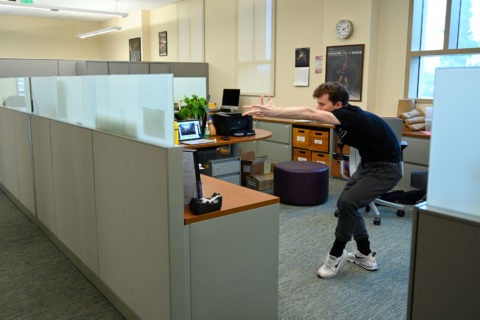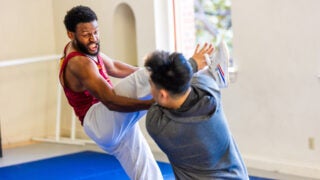A monumental behind-the-scenes effort is helping USC move classes online in response to coronavirus
Experts in information technology and teaching are assisting USC’s faculty and students in temporarily shifting to an online learning environment with tools like Blackboard and Zoom.
A few weeks ago, several thousand people were using USC’s new videoconferencing tool to teach and collaborate.
Now that number is at 30,212 and climbing.
It’s one sign of the massive changes underway as the university shifts to an online teaching environment through mid-April in response to the coronavirus pandemic.
Behind those dramatic changes is a team of administrators, information technology specialists and teaching experts who are working around the clock to make the transition as smooth as possible.
“Conducting classes remotely is a different experience for many of us, and there will be ongoing adjustments that we need to make,” USC Provost Charles Zukoski said. “I am grateful to see how well our faculty, students and staff have responded to this challenge and transitioned to online instruction. USC has much experience in delivering online education of quality and excellence, and we will build on this experience as we go forward.”
Teaching experts guide USC’s temporary shift to online classes
One major resource is the USC Center for Excellence in Teaching (CET). On the center’s website, instructors can review detailed guides to using the university’s online learning management system, Blackboard, and videoconferencing tool, Zoom. They can also call or email the center with specific questions or concerns.

“We are reassuring faculty that while this requires some additional work, and may feel very unfamiliar and uncomfortable at first, it is absolutely doable,” said Ginger Clark, associate vice provost for academic and faculty affairs, CET’s director and professor of clinical education at the USC Rossier School of Education. “They can do this, and we will help them in whatever way they need.”
More than 600 faculty members have attended the center’s training sessions in person or online in the past week. Two group trainings are being offered through Zoom each day moving forward, including during spring break.
The training sessions help instructors learn how to use tools like breakout rooms in Zoom to divide their classes into groups for small discussions. They can also upload course materials and create quizzes and tests on Blackboard, among many other functions.
Clark said she is already hearing success stories, including one faculty member who exclaimed: “It worked! I’m ecstatic!” That same instructor also wanted additional support to address a few minor hiccups in creating and administering an online exam.
“We want to hear about their successes and to help them fine-tune,” Clark said. “We aren’t just here to get them off the ground. We’ll work with faculty for as long as they wish, and I know our technology experts have expressed the same commitment. They are not alone in this.”
Tech support for online classes ramps up at USC during coronavirus response
Working in tandem with CET’s teaching experts are specialists from USC’s information technology team. They are monitoring the university’s online teaching tools and network infrastructure to ensure any technical glitches are kept to a minimum.
That can be challenging when use of a tool like Blackboard increases 33% in one day, like it did when USC officially made the shift to online teaching on March 11.
“From a nuts-and-bolts perspective, there’s a lot of work we have to do to prepare for an influx of people like this,” said Veronica Garcia, associate chief information officer for application services. “How many courses and sections do we have? Do we have enough technical capacity? Can it withstand everyone logging on at the same time?”
So far, the university’s systems are handling the increased demand well, Garcia said. A measure called the “frustration index” is used to monitor the responsiveness of the overall virtual classroom experience.
“We have to make sure the quality is there because now we’re supporting voice and video, which are very intolerant of any sort of network degradation,” said Susan Tincher, associate chief information officer for infrastructure services. “We have to make sure our network is capable of supporting these critical learning environments and collaboration systems.”
The team is also providing technical support to students and faculty and staff members at a dedicated website that features how-to guides, answers frequently asked questions and provides contact information for additional help.
“It’s not about just turning on a technology,” Garcia said. “It’s about truly getting people comfortable with what that means.”
Students adjust to learning online, find some advantages to digital classroom
When Kellie Miller joined her broadcast reporting class this week, she didn’t look around for a place to sit in a classroom on USC’s University Park Campus. Instead, she relaxed in her bedroom and logged in to the university’s videoconferencing tool.
“Picture the Brady Bunch theme song — that’s what it looked like,” she said. “Quite funny, to be honest. But my teacher was very understanding of the situation and we made it work. We still talked about our assignments and are coming up with a plan if in-person classes are canceled all semester.”
The master’s student in journalism at the USC Annenberg School for Communication and Journalism said her experience with the shift to online courses has been better than she expected. Although she still prefers learning in a physical classroom, she hasn’t had any challenges accessing her online sessions.
“There were no technical issues with Zoom,” Miller said. “I think the biggest challenge is keeping everyone focused during those Zoom sessions. I ‘zoomed’ from my bedroom and felt distracted very easily.”
As far as the mood among her fellow students, she said it’s varied. Some are taking advantage of cheap airfare deals to go to other states or even out of the country. Others feel anxious and worried about the situation. And yet other classmates are frustrated that they can’t travel for an immersive journalism experience as part of their final project.
“But at this point, it seems everyone is understanding,” she said. “I personally feel anxious but also optimistic.”
USC faculty members making transition to online teaching, learning new tech
Students aren’t the only members of the USC community experiencing dramatic changes in their day-to-day educational experience.
Take Keith Plocek, for example. He likes teaching journalism students how to use gadgets like GoPro cameras and drones to capture stunning footage and images for their stories. So when the surf journalist known for his course on Storytelling for Action Sports at USC Annenberg had to move his class online this week, he worried about how he’d teach those skills through a computer screen.

“Now we all have to rework our plans,” he said. “Some of that hands-on technical stuff is going to be a little difficult. Now we won’t be flying a drone together.”
But other aspects of using Zoom to teach his course surprised Plocek. When the class gathered online for the first time this week, he discovered it felt more egalitarian than having all his students focused on him at the front of a physical classroom.
“There’s a nice roundtable aspect,” he said. “In a sense, they were having more fun with it. I felt like it led to a better discussion. They could see each other’s faces, and they were all in it together.”
In addition to his position as a lecturer, Plocek is also a liaison between the school and its many adjunct instructors, most of whom are working professionals in the communications, journalism and public relations sectors.
He has spent the past week helping connect them to resources at the university as it became clear they would be teaching online for at least a month. Although many instructors have expressed anxiety about the process, Plocek said they are generally taking things in stride.
“They seem like they are flowing with it,” he said. “We’re sending out a lot of messages, and I think that’s helping them feel like even though it might not all be figured out, it’s coming together. They know people are working hard to support them.”



